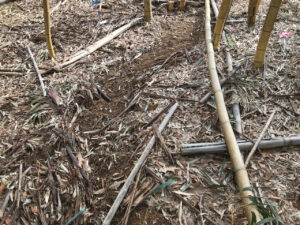David Harvey of Timber Bamboo Nursery:
“Don’t wait to plant bamboo. Plant bamboo and wait”.
Plant bamboo for income
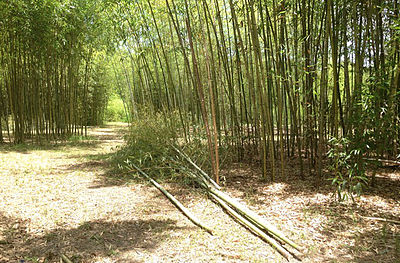
Bamboo is a food, fodder and fiber crop. Sell the shoots. Feed the leaves to livestock. Sell the poles. Bamboo sequesters carbon dioxide and protects soil from erosion. It is perennial and evergreen. Plant bamboo to complement your farm operation. Plant it on acreage unsuited for other crops if level acreage is not available.
Chip poles for mulch, compost or livestock bedding. Pelletize leaves and branches for animal feed. Cut poles to make charcoal and biochar.
Most bamboo people make income as bamboo nurseries. They sell plants, maintain groves for customers, and, remove unwanted bamboo. If you desire to plant acreage, contract with a bamboo nursery to grow the plants you need in the size you want.
Plant bamboo for beauty
![]()
![]()
![]()
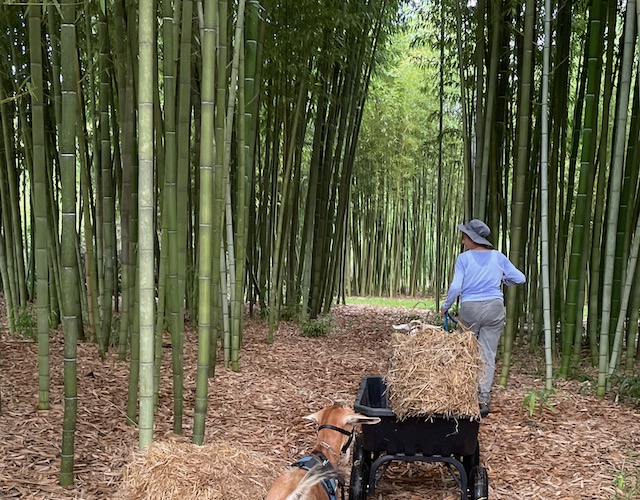 A maintained grove is a green and peaceful place. In winter when trees are bare, a grove of bamboo is green. Many people enjoy strolling in a bamboo grove to unwind.
A maintained grove is a green and peaceful place. In winter when trees are bare, a grove of bamboo is green. Many people enjoy strolling in a bamboo grove to unwind.
Unmaintained bamboo is crowded and has many dead and leaning and broken canes. I do not find these groves to be beautiful. Pic shows ears of one goat pulling a wagon with straw. Second goat follows behind the wagon. The straw will mulch the alley.
Plant bamboo to store rain water in the ground
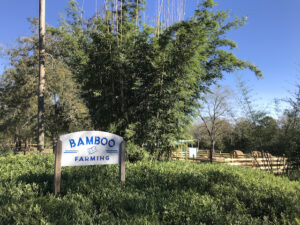
Plant bamboo to catch runoff from farm operations. Protect ditches, streams and farm ponds with a bamboo buffer. To save out planet, we must store water in soil. Water vapor from forests (trees and bamboo) pulls moisture from the oceans into our continents. Trees and bamboo create rain.
In the photo to the left, the dwarf bamboo (Shibatea kumasaca) is 6 years old. The original planting was five one gallon plants. No weeds come through it, it needs no irrigation, and soil does not run off.
The tall tropical bamboo is Weaver’s Bamboo (Bambusa textilis). It is five years old. The new shoots (you see them rising above the leaves) are taller than the canes with leaves. Textilis is on its way to its expected height of 40 feet. Once a year, I wade through the Shibatea and thin the Textilis. I remove all leaners and all canes in the middle. I maintain a hollow center like a doughnut and an outer ring that is a few canes deep. Without thinning, this bamboo, like most tropical bamboos, is impenetrable. Canes grow together like hair on a dog’s back. New canes have trouble growing straight up. It is difficult to harvest poles because the poles are so crowded and crooked and intertwined.
Plant bamboo to sequester carbon
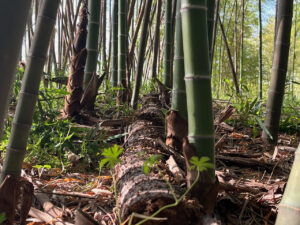 Plants take in carbon dioxide and convert it to sugars. The plant grows and it sends the carbon down to the roots and out through mycorrhizae to microbes in the soil. The living soil sequesters carbon. Therefore bamboo sequesters carbon in culms, rhizomes, roots, and in the living soil.
Plants take in carbon dioxide and convert it to sugars. The plant grows and it sends the carbon down to the roots and out through mycorrhizae to microbes in the soil. The living soil sequesters carbon. Therefore bamboo sequesters carbon in culms, rhizomes, roots, and in the living soil.
Bamboo is evergreen and photosynthesizes year around. “The capacity of bamboo for carbon sequestration and oxygen releases is 35% higher than those of trees.” (Zhaohua and Wei (2018)” p. 3 “Bamboo Shoot”, by Chongtham and Bisht.
This statement needs explanation. A new planting of temperate timber bamboo spends 10 to 12 years maturing. This is faster growth than trees and therefore more carbon capture than young trees. In the longer time frame, a bamboo forest continues to photosynthesise but older cane are decaying and releasing carbon. However, a bamboo farm has no decaying older canes. Its poles are harvested and used. Farmed bamboo is maintained in a vibrant youthful state because mature canes are harvested years before they would decay.
Bamboo is a giant grass.
Plant bamboo to hold the soil
Mulch helps with erosion control, but can wash away as is shown in photo to left. In a heavy rain, the water carried the mulch down slope. The tight mass of bamboo roots under the mulch held the soil together. The second photo shows a trench cut through bamboo roots and rhizomes. The network of roots that holds the soil is visible.
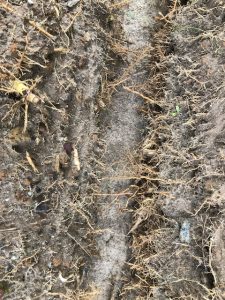
As a farmer, you plan to profit from a bamboo grove. If you farm to produce food, plant bamboo varieties that produce sellable shoots. If you have a buyer for poles, plant the varieties that they will buy. I met men who are paid to remove bamboo from properties. They make charcoal from the poles. They sell the charcoal to campgrounds where campers buy the special bamboo charcoal for cooking.
Plant bamboo to cool the planet
We all know that bare soils heat up in the sun. Water runs off of bare soil. Water can not soak into the ground. Plants absorb solar energy and keep the soil cooler. They transpire water and cool the air. People notice that it is 10 degrees cooler on a hot day inside a bamboo grove.
Let the bamboo protect the soil from crusting and baking. Let the bamboo pour carbon into the soil.
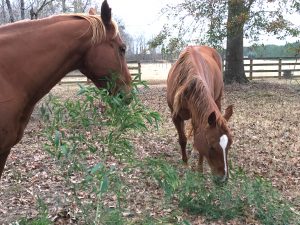 In West Virginia, abandoned coal mines will be planted with yellow groove. Yellow groove can be dug locally and transplanted to the site. When the new plantings mature, managers will grind branches and leaves for animal feed. They will cook poles for charcoal and biochar. They will harvest the by-products (vinegar and gas) for fuel.
In West Virginia, abandoned coal mines will be planted with yellow groove. Yellow groove can be dug locally and transplanted to the site. When the new plantings mature, managers will grind branches and leaves for animal feed. They will cook poles for charcoal and biochar. They will harvest the by-products (vinegar and gas) for fuel.
Most people who embrace the idea to plant bamboo think that they can sell poles to companies that make flooring, paper, or fabric. The volume of bamboo forest to support a milling company does not exist in the United States. Even in India, where bamboo forests are native, the percentage of paper made from bamboo has declined because of depleted stocks.
In April, 2014, I planted eleven varieties of bamboo in Hawkinsville, Georgia. I will sell shoots to my mail order customers beginning in 2021. I will harvest some of my black poles to sell. Weaker poles like vivax and dulcis, I will burn to make charcoal, and, chip to make mulch. My latest idea is to grow mushrooms under the bamboo. The mushrooms will digest the chipped bamboo and turn it to soil. I will harvest bamboo shoots to sell in March and April, and harvest wine cap and oyster mushrooms in summer.
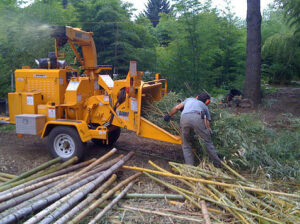 On a diversified farm, bamboo would be just one of many crops. On a bamboo plantation, bamboo would be the one crop. The variety/varieties chosen to be planted would be grown for a specific purpose such as biomass for energy or fiber for cardboard or selling bamboo shoots in March and April.
On a diversified farm, bamboo would be just one of many crops. On a bamboo plantation, bamboo would be the one crop. The variety/varieties chosen to be planted would be grown for a specific purpose such as biomass for energy or fiber for cardboard or selling bamboo shoots in March and April.
Examples of small-scale bamboo farming
- A farmer in Oregon has a grove of vivax bamboo. When the vivax starts to shoot, he sprays white paint on the shoots that he wants to grow into poles. He calls a local Asian woman. She arrives with friends. The ladies harvest every unpainted shoot. They pay him two dollars a pound for the shoots. His grove is thinned without his labor. It is open and beautiful to walk through. He did not have to do the work of harvesting and thinning. The white painted shoots remain to grow into poles. (The paint is on the sheath leaves, not the shoot. The sheath leaves fall off as the shoot grows.)
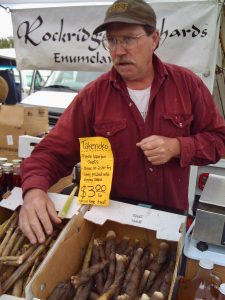
A farmer in Washington State sells fresh shoots to restaurants. A Japanese restaurant likes big shoots. His big shoots are from his vivax grove. The restaurant pays $5 a pound for shoots larger than a pound each. They buy $900 worth of shoots each delivery.
- A Florida farmer sells fresh-cut green poles for weddings on the beach. He cuts them when they are ordered. No storage problem.
- A Seattle chef grills bamboo shoots with sheath leaves intact. Guests peel the sheath leaves at the dinner table. They dip the shoots into an assortment of sauces and condiments. It is a festive evening for the guests.
- An Oregon farmer chips excess poles into mulch. He uses the mulch on the farm and sells it by the truckload.
- Another Oregon farmer raises two beef steer each year. Each day he cuts a couple of poles and ties them to the fence. His cattle eat the leaves. Two weeks before slaughter, he feeds only bamboo. “Best tasting meat ever”, he says. The cattle strip the leaves so the poles are ready to be delimbed, stored, and sold.
- Hominy Farms in Mississippi thins their groves, grabs the poles with the tractor, and hauls them to the cattle. The tractor lifts the poles over the fence and a week later, all the leaves are eaten. Cattle love bamboo leaves.
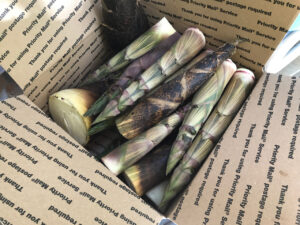 In 2020 I began selling bamboo shoots by Mail Order from established groves belonging to a friend. I place ten pounds of shoots in USPS Priority Mail boxes. The box cost customers $62. My postage is just under $22.
In 2020 I began selling bamboo shoots by Mail Order from established groves belonging to a friend. I place ten pounds of shoots in USPS Priority Mail boxes. The box cost customers $62. My postage is just under $22.
I had more orders than I could fill. I had planned on harvesting many shoots from my main moso research plot in Bonaire GA. For the second year in a row this moso grove produced zero shoots!!!
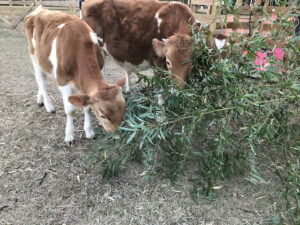 My dogs deliver fresh bamboo poles morning and night to my three bull calves.
My dogs deliver fresh bamboo poles morning and night to my three bull calves.
